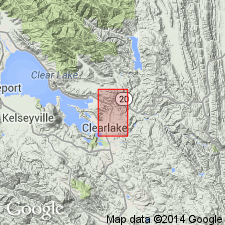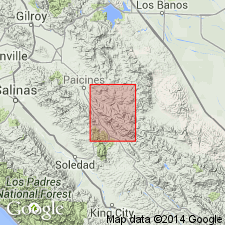
- Usage in publication:
-
- Gavilan limestone*
- Modifications:
-
- Original reference
- Dominant lithology:
-
- Limestone
Summary:
Pg. 128, 181. Gavilan limestone. In Gavilan Range [spelled Gabilan by US Geographic Board], some 60 miles south of Bay of San Francisco, the lowest sedimentary formation encountered is in part limestone, which at points is very crystalline. Associated with it are rocks of Archean gneiss type. It is possible it is a member of Knoxville series much more metamorphosed than usual, but it appears more probable it is a remnant of some older formation which has perhaps undergone repeated metamorphism. Present in San Francisco Bay region, western California. Age is pre-Jurassic(?).
Source: US geologic names lexicon (USGS Bull. 896, p. 788).

- Usage in publication:
-
- Gabilan limestone*
- Modifications:
-
- Overview
Summary:
Is now [ca. 1938] known to be of pre-Franciscan age, and in San Francisco region occurs as inclusions in quartz diorite that has been caled "Montara granite," of late Jurassic(?) age. (See also under Sur series.)
Source: US geologic names lexicon (USGS Bull. 896, p. 788-789).

- Usage in publication:
-
- Gabilan limestone
- Modifications:
-
- Overview
- Dominant lithology:
-
- Marble
Summary:
Pg. 193, 224 (fig. 3). Described as a white to bluish-gray, thoroughly recrystallized marble, commonly exhibiting faint banding. Occurs as isolated roof pendants in Santa Lucia granite and as fault breccia along San Andreas fault zone. Occurs in San Francisco Bay region, western California. Age is pre-Franciscan.
Source: US geologic names lexicon (USGS Bull. 1200, p. 1449).
For more information, please contact Nancy Stamm, Geologic Names Committee Secretary.
Asterisk (*) indicates published by U.S. Geological Survey authors.
"No current usage" (†) implies that a name has been abandoned or has fallen into disuse. Former usage and, if known, replacement name given in parentheses ( ).
Slash (/) indicates name conflicts with nomenclatural guidelines (CSN, 1933; ACSN, 1961, 1970; NACSN, 1983, 2005, 2021). May be explained within brackets ([ ]).

